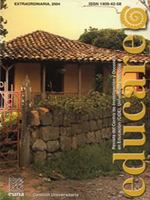Estrategia universitaria basada en habilidades
DOI:
https://doi.org/10.15359/ree.2004-Ext.4Abstract
Defining a global strategy that universities can use in order to fulfill their mission and their vision of the future constitutes a vital task for university authorities. A skill-based University Strategy model is introduced in this paper as a conceptual and methodological resource to be used in the analysis and definition of institutional strategies within a university. We hereby present the fundamentals of the project, describe its strategic scenarios, and explain the process of strategy creation. This is illustrated through the experience of the global process of planning that the Universidad Nacional, Costa Rica, has gone through.
References
Bricall. (2000). Informe Universidad 2000. Capítulo VIII. Gobierno y
administración. Revista Vivat Academia. Alcalá. http://www2.uah.es/
vi vatacademia/basedatos/bricall/cap8 .htm
Boyett, J. y J. Boyett. 1999. Hablan los gurús. Bogotá. Norma.
Burdano, G. (1999). La educación superior en la segunda mitad del siglo XX. Los alcances del cambio en América Latina y el Caribe. Revista Iberoamericana de Educación (21).
Dill, D. D. (1994). Defining the Common Good. Toe Use of Criteria in
University Strategic Choice Making. 161h Annual EAIRJorum. Amsterdam.
Guy, N. (2001). Educación superior. Historia y política. Estudios comparativos sobre la universidad contemporánea. Barcelona. Gedisa.
Hammel, G. y Parlad. C. K. (1990). El propósito estratégico. HarvardDeusto Business Review (primer trimestre), 90- 94.
Kaplan, R. y Norton, D. (2002). Cuadro de mando integral (The Balanced Scorecard). Barcelona. Gestión 2000.
Kaplan, R. y Norton, D. (2002). Cómo utilizar el cuadro de mando integral. Barcelona. Gestión 2000.
Massy, W. F. (1996). Reengineering ResourceAllocation Systems. Resource Allocation in Higher Education, USA. Ann Arbor: University of Michigan Press, 15-47.
Mintzberg, H. 1(988). Cómo modelar la estrategia. Harvard Deusto Business Review. (Segundo trimestre).
Mintzberg, H. (1988). La organización profesional. En Mintzber, H. y J. B. Quinn. (1988). El proceso estratégico. Conceptos, contextos y casos.
Miranda, R. y Carranza, F. (2002). Análisis de dificultades y habilidades distintivas. Universidad Nacional. Heredia, Costa Rica.
Porter. M. (1980). Estrategia competitiva. Técnicas de análisis de los sectores industriales y de la competencia. Traducido por Alfonso Vasseur Walls. sa impresión. México, D.F. Continental.
Porter, M. (1997). ¿Qué es estrategia? Revista INCAE 10(1), 35 - 52.
Rama, C. (2002). La masificación universitaria y la emigración profesional de América Latina y el Caribe en la Sociedad del Conocimiento: algunas preguntas sin respuestas. Seminario "Migraciones e Integración Regional" Caracas SELA / CAF/UNESCO - ESALC.
Richter, C. von. (2002). Palabras del Dr. Wolfgang von K1chter (lilZJ.
Seminario: Desarrollo de la calidad en universidades de América Latina. México, Universidad Nacional Autónoma de México, 8 -9.
Ruiz, A (2001). La educación superior en Costa Rica. Tendencias y retos en un nuevo escenario histórico. San José. Editorial de la Universidad de Costa Rica
Stalk, G., P. Evans y L. Shulman. (1992). Competir en habilidades, clave de la nueva estrategia empresarial. Harvard Deusto Business Review. Pp. 44-56.
Vucht Tijssen, van L.( 2002). Un programa estratégico para la investigación en la Universidad Nacional de Costa Rica. Universidad de Utrecht. Holanda.
UNESCO. (1998). Declaración mundial sobre la educación superior en el siglo XXI: visión y acción. Conferencia Mundial Sobre La Educación Superior. París. http://www.unesco.org/education/educprog/wche/
declaration_spa.htm
UNESCO. (1998). Marco de acción prioritaria para el cambio y el desarrollo de la educación superior. Conferencia Mundial Sobre La Educación Superior. París. http://www.unesco.org/education/educprog/wche/declaration_spa.htm
Universidad Nacional. (2004). Informe sobre planes de estudio ofrecidos por grado académico, según Unidad Académica, a diciembre 2003.
Universidad Nacional (2004). Plan Global Institucional 2004 -2014.
Published
How to Cite
Issue
Section
License
1. In case the submitted paper is accepted for publication, the author(s) FREELY, COSTLESS, EXCLUSIVELY AND FOR AN INDEFINITE TERM transfer copyrights and patrimonial rights to Universidad Nacional (UNA, Costa Rica). For more details check the Originality Statement and Copyright Transfer Agreement
2. REUTILIZATION RIGHTS: UNA authorizes authors to use, for any purpose (among them selfarchiving or autoarchiving) and to publish in the Internet in any electronic site, the paper´'s final version, both approved and published (post print), as long as it is done with a non commercial purpose, does not generate derivates without previous consentment and recognizes both publisher's name and authorship.
3. The submission and possible publication of the paper in the Educare Electronic Journal is ruled by the Journal’s editorial policies, the institutional rules of Universidad Nacional and the laws of the Republic of Costa Rica. Additionally, any possible difference of opinion or future dispute shall be settled in accordance with the mechanisms of Alternative Dispute Resolution and the Costa Rican Jurisdiction.
4. In all cases, it is understood that the opinions issued are those of the authors and do not necessarily reflect the position and opinion of Educare, CIDE or Universidad Nacional, Costa Rica. It is also understood that, in the exercise of academic freedom, the authors have carried out a rogorous scientific-academic process of research, reflection and argumentation thar lays within the thematic scope of interest of the Journal.
5. The papers published by Educare Electronic Journal use a Creative Commons License:














 The articles published by Educare Electronic Journal can be shared with a Creative Commons License:
The articles published by Educare Electronic Journal can be shared with a Creative Commons License: 



